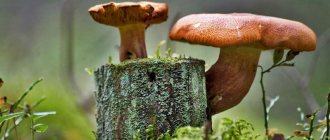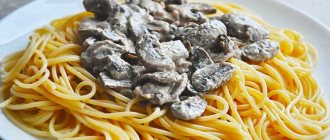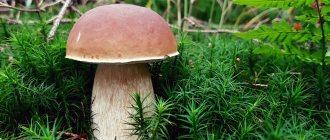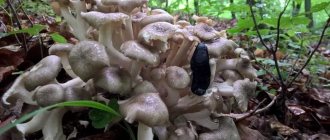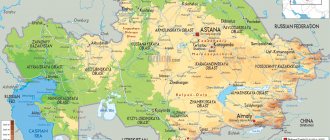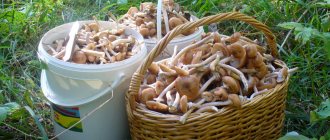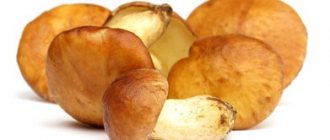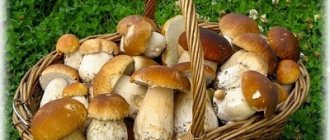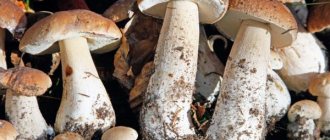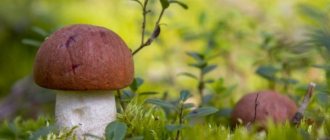Volvariella is a member of a family of little-known edible mushrooms. Under natural conditions, it is found in forests, on forest edges and clearings, in parks, shelterbelts, in meadows, fields, humus soil, on dead and living trees, trunks, stumps, on rotten wood, and litter.
Volvariella can be found on all continents except Antarctica. The name of the genus comes from the word volva - volva. The genus Volvariella has five synonyms: Volva, Volvarius, Pseudofarinaceus, Volvaria and Volvariopsis. The genus Volvariella contains edible and commercially cultivated species in Asian countries, especially Southeast Asia (China, Indonesia, India, Philippines, Malaysia). Volvariella esculenta, a straw mushroom, is also called the Chinese or Cantonese mushroom in accordance with its origin. It is a species of Volvariella volvacea and is referred to in older literature by this Latin name.
Volvariella cap is regular, thick or thin fleshy; with or without a tubercle, dry or slimy, silky, fibrous or smooth, reaches a diameter of 6 to 10 cm. It is colored light gray with a dark gray spot in the center. The edges of the cap are straight. Volvariella has many white, very thin plates (Figure 1). The plates are free, thin, frequent, whitish, then pink, brownish-pinkish, brownish-pink from spores.
Figure 1. Appearance of a straw mushroom
The change in color of the plates depends on the color of the spores, which varies depending on the age of the fungus. The spore powder is dirty or brownish pink. The spores are pink, pinkish under a microscope, straw-yellow, spherical or almost spherical, ellipsoidal, occasionally ovoid, smooth, non-amyloid, cyanophilic.
Basidia tetrasterigmata. Cheilo- and pleurocystids are numerous and varied in shape. Hyphae without buckles. The mushroom stalk is central, cylindrical, smooth, often widening towards the base into a tuber, with a sac-like volva, bare or pubescent, formed, heterogeneous, easily separated from the cap. Volvariella pulp is white, creamy, yellowish-creamy, without any particular odor or with a pleasant mushroom odor.
Young fruiting bodies are enclosed in a light brown shell - film (volva) - and resemble an egg. As the mushroom grows, the film bursts, and a white fringe remains at the bottom of the stem, reaching a length of 3-8 cm and a width of about 1 cm. “Rice straw champignon” has an excellent taste. In addition, 100 g of freshly picked mushrooms contain about 200 mg of vitamin C.
For the formation of the Volvariella fruiting body, temperatures from 28 to 30oC are optimal. Even at 35oC (on the substrate) she feels good.
Description and photo of Volvariella
Consider the mushroom Volvariella.
hat
Young mushrooms have egg-shaped caps that grow from the volva (the covering that protects the young body of the mushroom). During the process of growth, the volva remains at the bottom of the leg, and the cap changes its shape, first to a conical one, with a pronounced blunt tubercle in the middle, then to a flat one, and at the very end of growth to a convex one. The colors of the hat are varied.
Young mushrooms most often have a snow-white color, which changes over time. May be grayish, yellowish, light brown. The plates at the bottom of the cap also change color over time, from white to bright pink when the spores mature. It comes off easily from the leg.
Leg
The leg is either smooth or has a tuberous extension at the bottom. The thickness of the leg is from 0.7 to 2 cm in diameter. The shape is cylindrical, the color is white, but dark fibers may appear. The surface is smooth or pubescent.
Habitat
They grow mainly in mixed forests, parks, as well as in places of active human activity, for example, in vegetable gardens and orchards. Can be found on old compost heaps, rotten straw, rotting and drying trees. They grow singly, less often in groups.
Edibility
Volvariella is a conditionally edible mushroom; before use, it is necessary to boil it for 15 minutes, after which they can be fried, salted and pickled.
Spreading
Volvariellas love warm and humid climates. The mushroom is widespread in South Asia, the Philippines, Indonesia, and Madagascar. The growing season is considered to be the months from April to October. From July to September, mushrooms can also be found in countries with cooler climates, such as in central Russia. The mushroom has no culinary value, unlike champignons or truffles, but due to its mild and fresh taste it has won the love of connoisseurs around the world.
Definitioner
Basidia (Basidia) Lat. Basidia. A specialized structure of sexual reproduction in fungi, unique to basidiomycetes. Basidia are terminal (end) elements of hyphae of various shapes and sizes, on which spores develop exogenously (outside).
Basidia vary in structure and method of attachment to hyphae.
Based on the position relative to the axis of the hyphae to which they are attached, three types of basidia are distinguished:
Apical basidia are formed from the terminal cell of the hypha and are located parallel to its axis.
Pleurobasidia are formed from lateral processes and are located perpendicular to the axis of the hypha, which continues to grow and can form new processes with basidia.
Subbasidia are formed from a lateral process turned perpendicular to the hyphal axis, which stops growing after the formation of one basidium.
Based on morphology:
Holobasidia are single-celled basidia, not divided by septa (see Fig. A, D).
Phragmobasidia are divided by transverse or vertical septa, usually into four cells (see Fig. B, C).
By type of development:
The heterobasidium consists of two parts - the hypobasidium and the epibasidium developing from it, with septations (see Fig. C, B) or without them (see Fig. D).
Homobasidia is not divided into hypo- and epibasidia and in all cases is considered to be holobasidium (Fig. A).
The basidium is the site of karyogamy, meiosis, and the formation of basidiospores. Homobasidy, as a rule, is not functionally divided, and meiosis follows karyogamy. However, the basidia can be divided into probasidium, the site of karyogamy, and metabasidium, the site of meiosis. Probasidium is often a resting spore, for example in rust fungi. In such cases, the probasidium germinates into a metabasidium, in which meiosis occurs and on which basidiospores are formed (see Fig. E).
See Karyogamy, Meiosis, Hypha.
Pileipellis
Lat. Pileipellis, skin - a differentiated surface layer of the cap of agaricoid basidiomycetes. The structure of the skin in most cases differs from the inner flesh of the cap and may have a different structure. The structural features of pileipellis are often used as diagnostic characters in descriptions of fungal species.
Based on their structure, they are divided into four main types: cutis, trichoderma, hymeniderma and epithelium.
See Agaricoid fungi, Basidiomycete, Cutis, Trichoderma, Hymeniderma, Epithelium.
Ixocoutis
Cutis, consisting of hyphae immersed in mucus. The surface of the cap is oily, slippery or slimy.
Lat. Ixocutis.
See Kutis, Gifa.
Kinds
The Volvariella mushroom has the following types.
Volvariella viscous cap
It is considered the largest species of Volvariella.
The surface of the mushroom cap is smooth and slightly sticky to the touch. Diameter up to 20 cm. The shape of the cap of a young mushroom is similar to an egg. After growing, it becomes like a bell with a drooping edge; later the shape becomes flat with a pronounced tubercle in the center of the cap. The color ranges from white to gray, the color of the plates ranges from white to light pink. The leg is thin and long, up to 25 cm, white or yellow at the base and may have a gray tint. The stem of a young mushroom is pubescent, while that of an adult is smooth.
REFERENCE! The flesh of the mushroom is loose and does not change color after cutting.
The peculiarity of this species is its not too pronounced, but fresh smell and taste, reminiscent of cucumber or radish. Volvariella viscosa quickly loses its taste, so it is necessary to cook it as quickly as possible after collection, without leaving it for long, otherwise the dish will become tasteless. The mushroom is considered edible or conditionally edible, that is, it requires preliminary boiling. Most often they are salted or pickled.
This species grows in the middle zone, in the temperate zone. It lives on soils rich in humus and compost heaps. Almost never found in forests. It grows mostly singly, less often in groups.
Volvariella is beautiful
Grows on living or dead deciduous trees. The size of the cap is from 5 to 15 cm, sometimes it can grow up to 20 cm. In young mushrooms, the shape of the cap is ovoid; when ripe, the cap opens, its edge becomes jagged. Color ranges from white to straw yellow. The plates of the young mushroom are white; when the spores mature, they turn pink. The leg is smooth, long, diameter from 1 to 2 cm, evenly expanding towards the base.
The flesh of the mushroom is dense, but soft. It has a fresh taste, but is practically odorless.
In Russia, practically no one knows about this mushroom, but in some Asian countries it is considered an exquisite delicacy.
Volvariella beautiful, aka Volvariella beautiful
Another species, Volvariella is beautiful and edible. Grows on manured soil, compost heaps, and humus. Often found in orchards, parks, and vegetable gardens. Found between June and September.
The cap is white, in a young mushroom it looks like a bell, then it opens and becomes inverted. Color ranges from white or yellowish at the edges to brownish in the center. The stalk is up to 22 cm long in an adult mushroom.
Volvariella silky or bombicina
It is called silky because of its thin Volva of beautiful color. This species is found in mixed forests and parks; it attracts attention with its beautiful appearance, but is rare. In some regions of Russia, for example in Khakassia, Novosibirsk and Chelyabinsk regions, the species is listed in the Red Book and is protected by the state. This species is found in countries with temperate and hot climates. You can find it both in central Russia and in North America, China, and Australia.
The caps of this species of Volvariella are from 5 to 20 cm in diameter. The shape of young mushrooms is bell-shaped, opens when ripe, first becomes flat, with a pronounced blunt tubercle in the center, then becomes convex. The color ranges from light brown to mouse gray, and can also be light straw. The plates of the young mushroom are light pink, changing their color to bright pink after ripening.
The pulp is white or yellowish, dense, and has a light and pleasant mushroom smell. Volvariella silky grows actively from mid-June to the end of August. These mushrooms should be cut very carefully so as not to damage the mycelium. The mushrooms should not be twisted, as the cap will crumble too much.
This species is found in countries with temperate and hot climates. You can find it both in central Russia and in North America, China, and Australia. Experienced mushroom pickers know this species well.
Article on the topic - Row mushroom (Tricholoma): edible and poisonous species.
Spreading
As mentioned above, Volvariella bombycina is a fairly rare species of mushroom, so mushroom pickers do not collect it very often. The main habitat of this species is mixed forests, as well as quite large natural parks and protected areas. For its growth, Volvariella often chooses the wood of weakened deciduous trees, for example: willows, poplars, maples. The most active time of fruiting for this species of representatives of the mushroom kingdom is considered to be the summer season - from mid-July to the last days of August.
Some varieties of Volvariella can be grown artificially, which allows the person cultivating this species to collect a fairly substantial harvest of these tasty and rare mushrooms.
Similarities with other species
Volvariella are similar in appearance to conditionally edible float mushrooms. But if volvariella often grows on trees, then floats grow exclusively on the ground; in addition, the float has a dry cap and a fleecy leg, in contrast to volvariella, whose leg is smooth and the cap has a glossy shine.
They are also very similar to the white fly agaric. Inexperienced mushroom pickers may confuse them. The main difference is that the fly agaric has a ring on the stalk, while Volvariella has a completely smooth stalk, and the plates of Volvariella are colored light pink. In addition, fly agaric has a distinct smell of bleach, unlike volvariella, which has no specific smell at all.
ATTENTION : An inexperienced mushroom picker may mistake Volvariella for a toadstool.
Among Volvariella there is one inedible species. Volvariella parasitic. Outwardly, it is similar to silky volvariella, but the inedible relative grows in a group, which is almost never found in edible volvariella.
Can it be eaten?
Volvariella - although it belongs to the conditionally edible species, nevertheless, the majority of mushroom pickers who have encountered and collected this species consider it to be quite edible. The main condition for preparing this unique lamellar mushroom is the mandatory primary heat treatment, which involves boiling the fruiting bodies. The broth obtained after cooking the mushrooms is drained.
Growing Volvariella + video
In China, the cultivation of volvariella alternates with the cultivation of champignons. Volvariella is grown in the warm season, from April to October, champignons - in the cold season.
It is believed that Volvariella grown under artificial conditions have a more pronounced taste, unlike their wild counterparts.
In order to get a good harvest of mushrooms, you must remember that volvariella are very heat-loving mushrooms. In hot regions they can be grown in open ground; in regions with a temperate climate it is better to grow them in a heated room or in a greenhouse.
In China, they are grown using waste from cotton and rice production. Cotton substrate is laid out in the racks in a layer of 10 cm, then fermented rice straw in a layer of 15 cm. In Europe, these materials are difficult to obtain, so you can use prefabricated compost or any good quality straw.
To obtain fermented straw, it is necessary to moisten it properly and place it in a stack 1 m high. If necessary, additionally moisten the top layers. Then the stack must be compressed. The desired state can be achieved in 4-5 days, after which the material can be used for growing mushrooms. A fifteen-centimeter layer of prefabricated compost is placed in a box or rack, which is covered with ready-made straw.
The temperature of the substrate for grafting mycelium should be no higher than 35 degrees. As soon as the required temperature is reached, the mycelium is evenly distributed throughout the entire volume of the substrate.
Growing temperature 20-28 degrees Celsius, ideal humidity 85-92%. At lower temperatures, growth does not occur. Shelves should be protected from direct sunlight. However, it should be remembered that insufficient illumination, as well as insufficient or excessive humidity, lead to a decrease in yield.
If all conditions are met, then in just two weeks you can get the first fruits. If the temperature and humidity conditions are maintained, the mushrooms grow very actively.
For export, mushrooms are harvested immediately after the volva has fully opened; if the mushrooms are not for sale, then you can wait longer for the cap to open and the mushroom itself to grow.
After 60 days, the substrate is already considered spent, and the yield period of the volvariella mycelium has come to an end. Under favorable conditions in a warm climate, the yield reaches 80% of the weight of the substrate, but in central Russia, due to the colder climate, this figure is lower and reaches no more than 60%.
Ripening, harvesting
After a week, the fruiting bodies can be collected. In Asia, mushrooms are collected whose membrane has just opened. For your own needs, you can let them grow larger. Several waves of harvest occur with an interval of 5-10 days. After 30-60 days, the nutrients in the substrate dry up and cultivation can be stopped.
In Asia, when grown indoors, the yield is up to 80% by weight of the dry substrate (straw + cotton waste). In our latitudes and on our nutrient substrates, the yield is somewhat lower, but still quite high compared to other types of mushrooms.
Benefits of Volvariella Silky
Volvariella silky has a number of unique properties, which is why it began to be cultivated.
Firstly, freshly cut mushrooms contain up to 200 mg of vitamin C, with the norm being up to 100 mg for an adult. That is, only 50 grams of mushrooms is enough for an adult to satisfy the body's needs.
Secondly, the low calorie content and high nutritional value of volvariella is an excellent reason to include it in your diet for those who are watching their diet and want to lose weight. A small amount of mushrooms in the diet will help get rid of swelling and remove waste and toxins from the body. It will be useful for vegetarians to know that mushrooms are rich in healthy proteins, and it is useful to consume them in order to avoid protein deficiency in the body.
Thirdly, these mushrooms are used in alternative medicine for the prevention and treatment of certain types of cancer: melanoma, carcinoma and sarcoma. In combination with traditional medications, after chemotherapy, it gives an effective result in the fight against the disease.
Interesting Facts
Volvariella silky.
- Some species of Volvariella are cultivated artificially. They are especially valued in China, where in ancient times they were presented to the emperor as tribute. In many mushroom farms, these mushrooms are “replacers” for champignons. If the weather is hot, they grow volvariella; if it gets cool, they grow champignons.
- These mushrooms contain substances that facilitate rehabilitation after a course of chemotherapy.
Possible harm and contraindications
Like all mushrooms, volvariella has some harvesting features, non-observance of which can be harmful to health.
It is necessary to collect mushrooms in an ecologically clean area. Since mushrooms do not have their own excretory system, they accumulate everything that the environment contains. You cannot pick mushrooms near a busy road or in production areas, otherwise you may get poisoned by heavy metals, which usually contaminate the soil in such places.
If you are not sure that it is definitely Volvariella, such a mushroom should never be cut off, it may turn out to be poisonous.
At first, it is better to turn to experienced mushroom pickers. Which will show where and when it is better to collect a specific species, and it is better to take such a person with you and see everything clearly.
You should not pick mushrooms that are too large or too old, as they can be harmful to health. It is better to leave them to leave their disputes behind.
Never buy mushrooms from strangers. Even if it is Volvariella. It is unknown where and when it was collected. Even if the mushrooms themselves were collected in a clean place and do not contain harmful impurities, their shelf life is very short, so they may not have any taste due to their long stay in the cut state.
The collected mushrooms must be thoroughly washed. There should be no soil or dirt left on them.
It should also be remembered that mushrooms, despite all their benefits, are very heavy food for the body, so eating more than 300 grams per week is not recommended.
For the same reason, people with gastrointestinal disorders, children under 6 years of age, and elderly men and women should not consume mushrooms.
Definitioner
Basidia (Basidia) Lat. Basidia. A specialized structure of sexual reproduction in fungi, unique to basidiomycetes. Basidia are terminal (end) elements of hyphae of various shapes and sizes, on which spores develop exogenously (outside).
Basidia vary in structure and method of attachment to hyphae.
Based on the position relative to the axis of the hyphae to which they are attached, three types of basidia are distinguished:
Apical basidia are formed from the terminal cell of the hypha and are located parallel to its axis.
Pleurobasidia are formed from lateral processes and are located perpendicular to the axis of the hypha, which continues to grow and can form new processes with basidia.
Subbasidia are formed from a lateral process turned perpendicular to the hyphal axis, which stops growing after the formation of one basidium.
Based on morphology:
Holobasidia are single-celled basidia, not divided by septa (see Fig. A, D).
Phragmobasidia are divided by transverse or vertical septa, usually into four cells (see Fig. B, C).
By type of development:
The heterobasidium consists of two parts - the hypobasidium and the epibasidium developing from it, with septations (see Fig. C, B) or without them (see Fig. D).
Homobasidia is not divided into hypo- and epibasidia and in all cases is considered to be holobasidium (Fig. A).
The basidium is the site of karyogamy, meiosis, and the formation of basidiospores. Homobasidy, as a rule, is not functionally divided, and meiosis follows karyogamy. However, the basidia can be divided into probasidium, the site of karyogamy, and metabasidium, the site of meiosis. Probasidium is often a resting spore, for example in rust fungi. In such cases, the probasidium germinates into a metabasidium, in which meiosis occurs and on which basidiospores are formed (see Fig. E).
See Karyogamy, Meiosis, Hypha.
Pileipellis
Lat. Pileipellis, skin - a differentiated surface layer of the cap of agaricoid basidiomycetes. The structure of the skin in most cases differs from the inner flesh of the cap and may have a different structure. The structural features of pileipellis are often used as diagnostic characters in descriptions of fungal species.
Based on their structure, they are divided into four main types: cutis, trichoderma, hymeniderma and epithelium.
See Agaricoid fungi, Basidiomycete, Cutis, Trichoderma, Hymeniderma, Epithelium.
Ixocoutis
Cutis, consisting of hyphae immersed in mucus. The surface of the cap is oily, slippery or slimy.
Lat. Ixocutis.
See Kutis, Gifa.
Links
- Volvariella mucocephala on the website “Mushrooms of the Kaluga Region”.
- Volvariella mucocephala at RogersMushrooms.
- Volvariella mucocephala on MykoWeb: The Fungi of California.
- Kuo, M. (2004, November). Volvariella speciosa. Retrieved from the MushroomExpert.Com Web site: https://www.mushroomexpert.com/volvariella_speciosa.html
- https://gribowiki.ru/eatable/volvariella-shelkovistaya.html
- https://wikigrib.ru/volvariella-shelkovistaya/
- https://gribnikoff.ru/vidy-gribov/sedobnye/volvariella-volvovaya/
- https://gribnikoff.ru/vidy-gribov/uslovno-sedobnye/volvariella-shelkovistaya/
- https://wiki2.org/ru/volvariella_mucocephala
taxonomy
The species was first described in 1774 by the German naturalist Jacob Christian Schaeffer as Agaricus bombycinus
.
Throughout its taxonomic history, it has been shuffled into several genera, including Pluteus
(by Elias Fries in 1836),
Volvaria
(Paul Kummer, 1871), and
Volvariopsis
(William Alphonso Murrill, 1911).
Rolf Singer placed it in its current genus, Volvariella
, in 1951. Other names that have been applied to the species include Lamarck's
Amanita calyptrata
and August Johann Georg Karl Batsch's
Agaricus denudatus
(both published in 1783), but these are illegitimate names like Schaeffer's earlier 1774 name take precedence.
In 1949, Murrill described various flaviceps
from collections collected growing on magnolia wood in Gainesville, Florida.
Although he initially described it as a new species, Volvaria flaviceps
, Robert Schafer considered the variety
B. bombycina
.
Microspora
variety was first described in 1953, and was later (1961) named RWG Dennis;
palmicola
variety was originally described as a separate species,
Volvaria palmicola,
by Belgian mycologist Maurice Beely in 1928, and later as a variety of
B. bombycina
by the same author in 1937.
Root for the generic name Volvariella
(and
Volvaria
and
Volvariopsis
, the genera into which the species were previously placed) comes from the Latin
völva
, meaning "wrapper" or "covering".
The specific epithet bombycina
comes from the Latin root
bombyc
, or "silky". Common names for the mushroom include "silky shell", the "silky rosegill", "silver-silk straw mushroom", or "tree mushroom".
Trametes versicolor - multi-colored tinder fungus, "turkey tail"
Fungi of the genus Trametes are producers of a number of valuable biologically active substances, such as hydrolytic and oxidative enzymes, polysaccharides, sterols, substances with antimicrobial and antitumor activity, due to which they are widely used in various industries and medicine. Currently, on their basis, environmentally friendly, waste-free technologies are being developed for the production of medicines, food additives, animal growth stimulants, as well as modern methods for recycling waste from the wood processing, textile and agricultural industries.
Figure 4. Trametes versicolor - multi-colored tinder fungus
T. versicolor is a producer of various extracellular hydrolytic and oxidative enzymes, the main of which are laccase, lignin and manganese peroxidases, which are widely used in various applications: the production of bioplastics, biofuel cells, textile and pulp and paper industries. Thus, in Europe and the USA, the production of the laccase enzyme from T. versicolor has been widely established, which is widely used in wood processing, paper, textile production, as well as for medical purposes in the creation of test systems for the detection of various phenol derivatives in the environment, food products and medicinal products. means
Traditional Chinese and Japanese folk medicine have used the healing properties of Trametes for centuries. So, at first in East Asian countries they were used in the form of tinctures and teas. But they became objects of various studies only since the 60s of the last century. The authors of Japanese patents of those years proposed the following species of this genus as producers: T. hirsuta, T. pubescens, T. versicolor and T. zonatus.
Preparations based on T. versicolor are recommended for athletes in the USA and Portugal to strengthen the immune system, and are also intended for immunocorrection and treatment of viral and oncological diseases of domestic animals.
Scientists of the State Research Institute for the Search of New Antibiotics named after. G.F. Gause conducted studies to study the antitumor activity of aqueous extracts of mycelium and total water-soluble polysaccharide fractions of the fungus T. versicolor in in vivo experiments on BDF1 hybrid mice inoculated with lymphocytic leukemia P388 upon oral administration. The data obtained indicate their reliable antitumor activity.
* * *
In general, a review of the literature shows a wealth of experience in using the fruiting bodies of basidiomycetes as sources of physiologically active substances. The search for new producers continues to this day. Collections of producers are expanding, which makes it possible to develop biotechnology for obtaining new compounds based on basidiomycetes, which will be of great scientific and practical interest.
However, despite the fact that the properties of fruiting bodies have been known for a long time, determining the conditions for cultivating mycelium and developing methods for its growth, determining the biochemical composition, and assessing various types of activities, such as antitumor and immunomodulatory, have been little studied. This area is still waiting for its researchers, and will certainly open up new prospects in pharmacology and biotechnology.
Description
Fruit bodies (ascocarps) are cylindrical or flattened with dimensions of 3–8 centimeters (1.2–3.1 in) tall × 2–8 mm thick. The erect ascocarps are often twisted or bent, and typically sparsely branched, often in a shape resembling a stag's antlers. Specimens found earlier in the season, in spring, may be covered completely in asexual spores (conidia), which manifests itself as a white to grayish powdery deposit. Later in the season, mature ascocarps are charcoal-black, and have minute pimple-like bumps called perithecia on the surface. These are minute rounded spore bearing structures with tiny holes, or ostioles, for the release of sexual spores (ascospores). The perithecia are embedded in the flesh of the ascocarp, the stroma, which is tough, elastic, and white. Within the perithecia, the asci are 100 × 8 µm.
Ascospores are kidney-shaped, black, and smooth, with dimensions of 10–14 × 4–6 µm. The asexual spores (mitospores) are ellipsoid in shape, smooth, and hyaline.
Morphology
Fruit bodies
capped, central or eccentric, small to medium in size. Types of development: bulbangiocarpous and pileocarpous.
hat
regular, initially bell-shaped or hemispherical, opens to convex or umbrella-shaped, may have a central tubercle, easily separated from the stalk. The surface is dry or slimy, smooth, fibrous or silky, white or colored.
Pulp
from white to creamy yellow, usually does not change when cut, sometimes slightly colored, the smell is not pronounced or pleasant, mushroom.
Hymenophore lamellar
, the plates are free, at first white, then pink to brownish or brownish-pink.
Leg
cylindrical, smooth, at the base may have a tuberous expansion, heterogeneous, fulfilled. Surface bare or hairy
Remains of bedspreads
: the ring is missing, young mushrooms are completely covered by a common blanket, then it breaks, leaving a clearly visible bag-like volva and fragments on the cap, which are easily separated from the surface and quickly disappear.
Spore powder
from pink to brownish-pink,
spores
are ellipsoidal, less often ovoid, smooth, non-amyloid, cyanophilic. The color of the spores can vary depending on the age of the mushroom from straw yellow to pink.
Trama
plates of inverse structure, there are numerous pleuro- and cheilocystids of various shapes.
Hyphae
without buckles.
